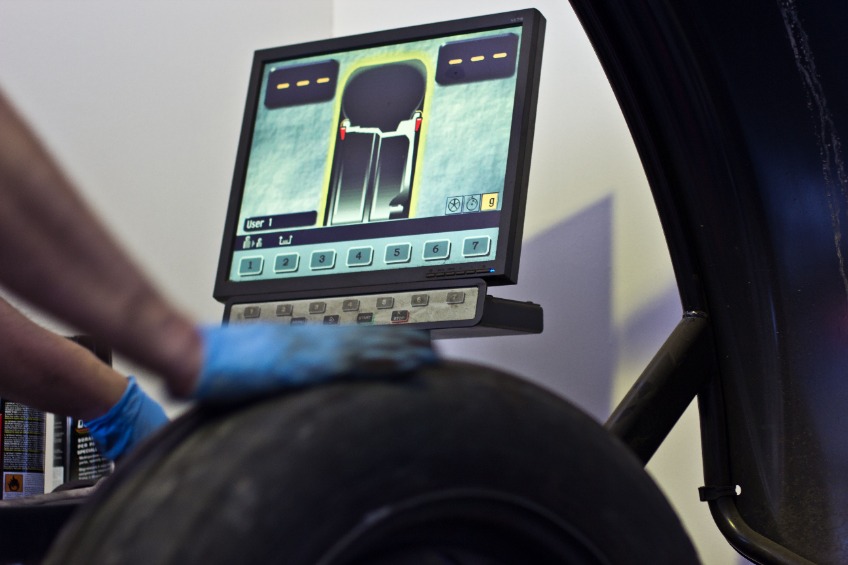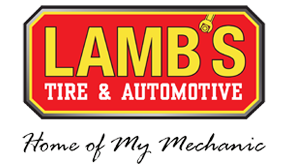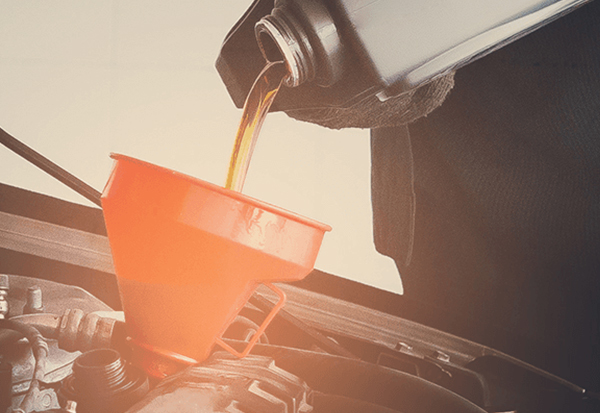The Comprehensive Guide to Tire Balancing & Tire Rotations

The tires on your vehicle not only help get you from one place to another, but they also serve a critical role in ensuring the safety of you and your passengers while on the road. That’s why it’s so important to do everything you can to keep your car’s tires in optimal condition. Including them in your vehicle’s preventive maintenance routine will help you do just that.
Regular tire rotation and balancing are two easy services that’ll help assure your vehicle’s tires are safe to drive on, ensure optimal tire performance, and help protect your investment in new tires.
This comprehensive tire rotation and tire balancing guide will cover everything you need to know about these two important tire maintenance services.
Tire Rotation Service
Each of your vehicle’s tires is subjected to varying levels or types of stress, causing them to all wear at different rates. But having a routine tire rotation service done will help maximize the lifespan of your tires by ensuring more even tread wear.
Getting Your Tires Rotated
For a tire rotation service, the mechanic will take off each tire/wheel assembly on your vehicle and move/rotate it from one position on the vehicle to another, often moving the front tires to the rear of the vehicle and the rear tires to the front. Or sometimes, the mechanic will move the tires on the driver’s side to the passenger side and the passenger-side tires to the driver’s side. For some vehicles, the tire rotation will involve a combination of the two movements, moving tires in an “x” pattern. The exact pattern depends on whether your vehicle is front or rear-wheel drive and what movement was used at your last rotation service.
If there are two good tires and two worn tires, the better tires will usually be put on the rear of the vehicle to help prevent fishtailing, regardless of whether your vehicle is front-wheel, rear-wheel, or all-wheel drive.
While your vehicle is in the tire shop to have the tires rotated, the mechanic will also visually inspect them, checking for any other issues that could affect tire safety or performance. The mechanic will:
- Examine the tread wear on each tire
- Check each tire for any damage or foreign objects
- Check each tire’s air pressure and adjust as needed
- Tighten any loose wheel lug nuts
Catching minor issues early can help prevent them from becoming a major problem down the road (one that equals the need for tire replacement).
The expert mechanics at your nearest Lamb’s Tire & Automotive location can quickly and properly rotate your car’s tires, let you know if there are any issues, and help you select the perfect replacement tires when the time comes.
Schedule tire rotation appointment online today!
Benefits of Routine Tire Rotation
Tire rotation is one of the fastest and easiest ways to help protect the tread on your vehicle’s tires and your vehicle’s safety and efficiency on the road. Some of the specific benefits of regular tire rotations include the following:
- Ensuring even distribution of tread wear on the tires
- Preventing “cupping” from occurring on the tread
- Reducing added stress on other components (especially within the suspension and brake systems)
- Helping to maintain optimal handling and vehicle safety
- Ensuring optimal fuel mileage (saving you money!)
Without regular tire rotations, a deep, irreparable, and uneven wear pattern can develop on your car’s tires, decreasing its handling and causing it to pull to one side while driving, both of which are dangerous. Also, because worn tires strain your vehicle’s engine, it can lead to decreased fuel efficiency.
Tire Rotation Schedule
When your vehicle’s tires are relatively new, the deeper tread is more susceptible to uneven wear. That’s why we recommend having newer tires rotated at the 5,000-mile mark.
For tires past 5,000 miles, it’s best to stay on a rotation schedule of every 6,000 to 8,000 miles to promote even tread wear and maximize tire life. A good habit to get into is to have your car’s tires rotated and inspected during the same service appointment for the routine oil and filter change.
Tire Balancing Service
Normal manufacturing imperfections and everyday wear can cause weight imbalances on your car’s tires. When one or more tires are out of balance, it can cause a vibration in the steering wheel, seat, or floorboard, especially at faster speeds.
A vibration in the steering wheel often indicates an imbalance on one or both front tires, while a vibration in the seat most often indicates a rear-wheel imbalance. Out-of-balance tires will also wear faster or unevenly, leading to reduced fuel economy.
Schedule a tire balancing online today!
Getting Your Tires Balanced
Tire balancing is like a tune-up for your car’s wheel/tire assembly. This service ensures that the weight is evenly distributed around the wheel’s circumference. When it is, the tires will roll smoothly, wear more evenly, and last longer. Even though it’s a quick service, it does require expert experience and precision.
During a tire balancing service, we will remove the wheel/tire assemblies and mount them one at a time onto specialized balancing equipment. This equipment enables the mechanic to pinpoint any imbalances. The mechanic will then attach small lead weights, often weighing fractions of an ounce, in precise locations to the wheel rim to correct the imbalances and then remount the wheels/tires onto the vehicle.
The tires’ balance should be checked every two years, at the very least. If you regularly drive on bumpy roads, you should have the balance checked yearly.
Tire Balancing Schedule
Bring your vehicle to your closest Lamb’s Tire & Automotive location for tire balancing service if:
- A weight that was on the rim has fallen off.
- You feel a vibration in the steering wheel, seat, or floorboard.
- Your vehicle has uneven tire tread wear, especially in a cupping pattern.
- You’ve had a tire repair done.
- You’ve had new tires installed.
- You haven’t had tire balancing done in a long time.
We often recommend having a tire rotation and balancing service done simultaneously because both require removing the wheels/tires.
The Difference Between Tire Balancing and Tire Alignment
The terms “tire balancing” and “tire alignment” are often confused. Both services help maximize tire performance, drivability, and safety, but they are, in fact, two different things.
Tire balancing ensures that the weight of a tire is distributed evenly and the wheel/tire assemblies are spinning on the road properly. Alternatively, with a tire alignment service (aka wheel alignment), the driving angles of the wheels are checked and adjusted as needed, ensuring your vehicle is tracking straight while driving and helping prevent premature/uneven tread wear.
Additional Ways You Can Help Maintain Your Vehicle’s Tires
As you can see, regular tire rotation and balance will significantly help ensure even treadwear and optimal performance from your car’s tires for as long as possible. There are some easy, additional things you can do to extend the lifespan of your car’s tires significantly, further subsidizing the benefits these tire maintenance services will provide, including:
- Maintaining proper air pressure: This is the easiest way to help extend the life of your vehicle’s tires. Check the air pressure at least once a month and more often if you’re putting a lot of miles on your vehicle.
- Frequently inspecting the tires: The sooner things like punctures, gouges, or embedded objects are caught, the higher the chance of tire repair. So, make sure to inspect the tires closely every couple of weeks.
- Avoiding hazards: Avoid driving over uneven pavement, potholes, and other road hazards as much as possible. Doing so will help prevent tire imbalances and alignment problems that can cause uneven tire tread wear.
- Avoid excess weight: Make sure you stay below the tires’ max load capacity when you’re hauling heavy loads or towing.
Optimize the Performance of Your Tires—Schedule Your Tire Appointment Today!
When you need professional tire rotation and balancing for your vehicle, visit the experts at Lamb’s Tire & Automotive. Our experienced ASE-certified mechanics can help ensure you get the best performance from your car’s tires while also providing an unmatched level of service.
Our team can help determine your vehicle’s proper tire maintenance schedule based on its tire type and your driving habits.
Along with tire rotation and balancing, we specialize in a full range of tire and wheel services to help keep your vehicle safe on the road, including:
- Wheel alignments
- Flat tire repair
- Tire pressure monitoring system (TPMS) repair
- New tire installation
Make Lamb’s Tire & Automotive your go-to auto service shop in Austin and the surrounding areas. Our professional team has the experience and expertise to meet all your auto maintenance and repair needs at reasonable prices, all while providing exceptional customer service.
Tire Rotation & Tire Balancing FAQ
How often should you rotate tires?
The deeper tread on new and relatively new tires is much more susceptible to uneven wear. That is why it is recommended to have a tire rotation done at the 5,000-mile mark for newer tires.
For tires that have passed 5,000 miles, a tire rotation schedule of every 6,000 to 8,000 miles should be followed to ensure even tread wear and help maximize tire life. A good vehicle maintenance habit to get into is to have a tire rotation and balance done during the same service appointment as your routine oil and filter change.
How do I know if my tires need rotating?
The best way to know for sure if it’s time to rotate tires is to have them inspected by a professional. But, in the meantime, there are some warning signs to look out for that can indicate that you need a tire rotation done. These include:
1. Individual tires wearing unevenly: Check the tread of your tires closely. A need for tire rotation will often present itself as uneven tire tread wear on individual tires. This can also indicate that your vehicle is out of alignment.
When you look at your tires, you’ll see small horizontal bridges between the grooves of the tread. As the tread wears down, these horizontal bars will become more flush with the tire. Tires should be replaced before these bars become totally flush. But, if you notice that the tread on one side of one or more tires is wearing away more rapidly than the other, have the vehicle inspected; a tire rotation probably needs to be done.
2. Uneven tread wear from front to back: Another thing to check is how your tires on the front axle are wearing compared to the tires on the vehicle’s back axle. If the tread on one set of tires is more worn than the other, you should have the tires rotated.
3. Vibrations or shaking: Under ideal conditions, you should not feel any unusual vibrating or shaking when driving your vehicle. If it does begin to vibrate, even at higher speeds, it could indicate that the tires are unevenly worn. In this case, the shaking and/or vibration will most often be felt in the steering wheel.
The life expectancy of your vehicle’s tires largely depends on the specific type of tires, your driving habits, the type of vehicle, etc. Keeping up with routine tire rotation service will significantly help extend the life of your tires.
What does an unbalanced tire sound like?
There is a range of sounds that can be produced by an unbalanced tire. Depending on exactly how out of balance it is, you may hear a light humming noise or even a loud, vibrating roar.
These noises are because the heavy spot on the tire/wheel causes the wheel to wobble as it spins. This wobbling generates a vibration, which causes the noise you hear. Generally, the louder and more severe the noise, the more unbalanced the tire is.
Does tire rotation affect alignment?
Though both services help promote even tire wear across all four tires, a tire rotation will not affect your vehicle’s wheel alignment. So, you don’t need to have the alignment adjusted every time the tires are rotated.
However, it’s still important to follow the recommended schedule on when to have both of these services done. Not only will they help extend the life of your tires, but they will also help pinpoint any other issues that may be present. For example, if your vehicle is misaligned, it is usually noticeable when the tire rotation is being done.
How long does it take to balance a tire?
Usually, tire balancing is a quick and straightforward process. Keep in mind that most tire manufacturers will recommend balancing all four tires during the service visit if the tires have been driven on for 7,000 miles or more. On average, it takes between 30 and 45 minutes to balance all four tires.
It can take a little bit longer if a tire needs to be rotated on the wheel or if the road force balancing method is used. The type of vehicle and the state of the tires themselves can also impact how long the service takes.
To avoid adding to your overall wait time at a tire shop, it’s always a good idea to schedule an appointment for your tire balancing service. If you just walk into a shop when they are busy, you might have to wait a while before the shop can even get to your vehicle.
Is it normal for my steering wheel to shake after a tire rotation?
It is not uncommon to experience some steering wheel vibrations after a tire rotation is done, but it will usually fade within the first 50 miles after service. If the vibration does not improve or is severe, it can be due to a couple of different things, including:
1. Tire imbalance: The most common cause of a shaking steering wheel after a tire rotation, especially when driving at higher speeds, is a tire that is out of balance. A small imbalance that doesn't cause a vibration at low speeds will become more noticeable as you accelerate. Often, when an imbalanced tire is rotated from the rear axle to the front axle, the vibration will get worse. A slight imbalance in a rear tire is much less noticeable than a tire/wheel connected to the steering wheel.
2. Uneven tire wear due to vehicle misalignment: Uneven tire wear is another common reason for a mild vibration in your steering wheel after a tire rotation. Minor vibration and/or shaking will usually subside after the tires have worn into their new positions.
However, uneven tire wear is quite often a result of vehicle misalignment, and if not corrected, a tire rotation alone will not solve the problem. So, if you have not had an alignment service performed in a while and are experiencing vibration after tire rotation, you should consider having an alignment performed.
3. Warped brake rotors: Vibration and shaking when braking after a tire rotation service is often caused by warped brake rotors that have had their lug nuts overtightened. In this case, the vibration/shaking will happen as the brake pads pulse against the warped rotor to try and stop the vehicle.
Usually, lug nuts have a required torque setting. When a torque wrench is properly used, it will identify when enough torque is applied and when to stop tightening the lug nuts to protect the rotors, studs, and lug nuts from damage.
Remember that anything more than just a very slight vibration is not normal. If you have prominent and persistent vibration, especially if it gets worse at higher speeds, you should consider tire rebalancing and alignment. These tire maintenance services will address the root causes of steering wheel shaking/vibration.
How long can you drive on unbalanced tires?
Driving on unbalanced tires can be risky, but not everyone can fix them immediately. Generally speaking, you can drive on unbalanced tires for two to three months. However, you shouldn’t stretch it much longer than that.
The danger doesn’t lie solely in the unbalanced tire itself, but it can cause problems that can be dangerous. These include:
1. Dangerous impact on handling: The most important consequence of driving on tires that are unbalanced is the safety risk. Unbalanced tires can cause a loss of traction, making it harder to control your vehicle. This can lead to an accident and, in extreme cases, even a fatality.
2. Extensive tire wear: Unbalanced tires put a lot of pressure on the wheel and the tire itself. This causes increased wear and tear on the axle and uneven wear on the tread. This increased, uneven wear can cause problems with the vehicle’s handling or even a tire blowout. Having to replace tires or suspension parts will be much more expensive than getting the tires balanced.
3. Dangerous impact on the suspension system: Two of the main jobs of the suspension system are to reduce any vehicle vibration and to provide a comfortable ride. Since unbalanced tires will cause a progressively increasing vibration, the pressure put on the suspension system will also increase, leading to more damage done to the vehicle.
The increased wear and tear on this system will also make your vehicle less safe to drive. Remember, the cost of fixing the suspension system will be much higher than the cost of having your tires balanced.
4. Consistent vibration: Driving on unbalanced wheels will cause a consistent vibration through not only the steering wheel but the whole vehicle, which will impact your comfort in the vehicle while on the road.









